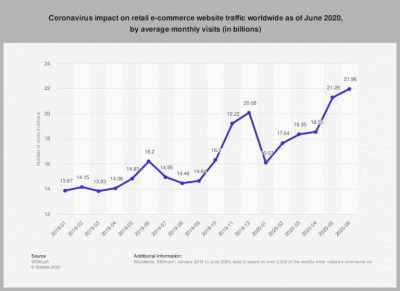2020 was a year people looked forward with greater expectations, a year in which innovative technologies would be introduced and a lot of new job opportunities were predicted for the younger generations. But barely halfway through, people are hoping it becomes 2021 already, because there is nothing to look forward to except for a vaccination against the coronavirus or maybe a new Netflix show!
It is also made quite evident that this year has had a profound impact on how people work, shop and live. Every business, small to medium has been affected; people’s lifestyles have changed dramatically, they are forced to sit at home, travel has been restricted, even meeting and greeting people in public has been considered a legal offense. Who would have thought normal human life would change this drastically, in just a year? When it comes to enterprises, there has been a serious and sudden shift to a new normal which carried its own potential risks. However, with innovation such as cloud service models and IoT services enterprises around the globe are rising to the challenge in unparalleled ways. Investing ambitiously in innovative technologies, adapting to the new norm and transitioning to flexible working conditions has helped enterprises manage the crises.
For the general public, the period of pandemic, self-isolation, and economic uncertainty has changed the way they behave, how they shop as well as how they entertain themselves. These rapid shifts has made a huge impact on retailers and consumer-packaged-goods companies. Many of the long-term changes in consumer behavior are still being formed, giving companies an opportunity to help shape the Next Normal. The extraordinary demand within certain categories has to a large extent been captured by pure online companies, as a result, everything from online shopping and entertainment to virtual healthcare and conferences has become a necessity rather than a lifestyle.
Impact of COVID-19 on E-commerce Industry
Throughout isolation and uncertainty, we’ve witnessed how people have swerved from their usual buying patterns. Consumers have shifted their focus from brick-and-mortar shopping to online shopping, with more and more cities going under lock-down, and consumers avoiding public places, businesses are forced to turn their focus to online presence.

Image source: SEMrush.com
Along with big players like Amazon, Flipkart, and Big-basket, local brick and mortar marts have also leveled up their competition. To avoid disruption, brands have started adapting and envisioning to become more flexible to meet the changing needs. Overall, retail websites generated almost 22 billion visits in June 2020, up from 16.07 billion global visits in January 2020. This sudden explosion in website views has not only helped retailers but web application development companies as well, as more traditional retailers adapted digitalization to stay relevant for their customers. The fact that many people shelter at home to avoid crowded stores has resulted in consumers turning to the internet to procure everyday necessities such as groceries or food.
Is It Safe to Order Online?
Given the fact that how infectious the coronavirus is, shoppers have raised concerns about the safety of receiving their orders. Experts say that the virus can live on surfaces for three to four hours.
Having said that, the World Health Organization has a different stand. WHO states that it is safe to receive packages from locations with reported COVID cases. Their official statement says the likelihood of an infected person contaminating the package is very low, as the package moves, travels, and is exposed to different climate conditions and temperatures.
It is very unlikely the virus would survive on any purchased item, from the time of package to the time of delivery. The shipping conditions and delays in the supply-chain make it even harder for potential contamination of packages. To add more ground to the statement, the Center for Disease Control and Prevention’s report says that the threat of spreading the virus from products or packages that are shipped over days or weeks at room temperature is very low.
Different Sectors That Adopted Digitalization Due to COVID-19
While adopting digitalization is not something new to the industry, the pandemic has remarkably accelerated the adoption of digital technologies, with far-reaching implications for the future. Other than going digital, enterprises will need to ensure that their digital channels are on par with or better than those of their competition to succeed in this new environment. Though E-commerce sectors were already aligned with digitalization, several other sectors around the globe were forced to adopt digitalization because of the pandemic.
Some of the other sectors include:
Financial Institutions
Banks have transitioned to remote sales and service teams and launched digital outreach to customers to make flexible payment arrangements for loans and mortgages.
Grocery Stores
Grocery stores have shifted to online ordering and delivery as their primary business.
Educational Sectors
Schools in many locales have pivoted to 100 percent online learning and digital classrooms.
Healthcare Sectors
Doctors have begun delivering telemedicine, aided by more flexible regulation.
Manufacturing Industries
Manufacturers are actively developing plans for “lights out” factories and supply chains. The list goes on.
Global Response: A Transition To E-commerce Way of Life
Recent research data from Bazaarvoice Network shows how the online shopping pattern has fluctuated throughout the COVID crisis. Data suggest that during the early stages of lockdown, in March, customers adopted e-commerce shopping and began setting themselves up for what seemed to be a longer period at home. The market has seen a 21% increase in online orders during March 2020 against March 2019. Now, when we compare the data month-on-month, in April 2020 the change spiked to 96%.

Image source: bazaarvoice.com
It’s not a surprise to see people opting for online shopping. With stay-at-home requests set up around the nation, a huge increment in individuals ordering everything from groceries to sanitizers to electronic devices online may be normal. The implementation of travel ban and social distancing along with the exponentially growing percentage of households that have access to the internet has proved to be the key factor for online shopping growth.
Brand Creation: More Clarity Less Ambiguity
There is rarely an angle within an industry that hasn’t been influenced by technology. The retail industry is no exception when it comes to adapting cutting edge technology to deliver an improved shopping experience. Successful implementation of AI-powered chatbots and voice-assisted product search has helped retailers to engage 24/7 with their customers and provide them with a personalized shopping experience. Through the improved customer experience by utilizing instant virtual communication, automated customer support, seamless data management and data security, retailers have begun to interact more specifically with customer needs and demands. This level of personalization would have been otherwise impossible for retailers to attain in a traditional brick-and-mortar environment.
Since artificial intelligence’s smart algorithms can predict consumer behavior, the e-commerce platform will be able to recommend useful or relevant information on products and services to customers. AI and machine learning help to forecast such information by analyzing customer’s search history and other data. This enables them to efficiently suggest related products and services.
Another aspect of technology that transformed retail is cloud computing. The different cloud service models arm in managing and processing data for instant access on any given device by anyone who needs it. In the case of e-commerce, a cloud ERP model can improve the monitoring of shipment, make the store more adaptable, and avoid ambiguity in navigation.
To keep up with the competition artificial intelligence, chatbots, voice assistance, and personalized user experience are necessary for any e-commerce business. By avoiding these inevitable technologies, it’s quite evident that the enterprises may remain stranded.
Conclusion
The growth of the digital business is on the rise and is quickly becoming an invaluable part of everyday life. Firms are banking on breakthrough innovations to win more consumers and create unique online experiences as more people embrace emerging technologies. As technology continues to advance, the e-commerce industry is expected to hit unimaginable growth levels by 2021.
Originally published on https://thinkpalm.com/

















